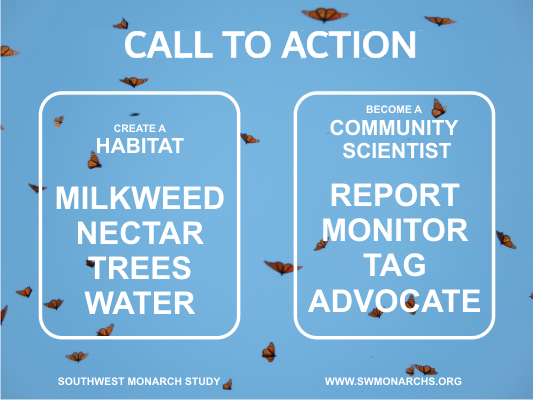
|
|||
|
|||

|
The monarch overwintering population along the California coast is dangerously low, so what can we do to help in the Southwest?
It's easy to panic, but it's important to act. There are still monarchs in the warmer regions of Arizona and California this winter that will begin their Spring migration soon. Remember, small numbers of monarchs also return from Mexico through Arizona and New Mexico as well. The best way we can gain a greater understanding and help monarchs in our region is a two-fold effort: Plant suitable habitat so monarch numbers can expand and focus on Community Science monarch research to fill in the data gaps of understanding. We've created this Shout for Action list to jump start everyone to step in and make a difference.
Remember: More Milkweed means More Monarchs. The key is creating habitat: Plant NATIVE milkweed, spring and fall monarch favored nectar, with trees or tall shrubs to the west for protection from our blazing summer afternoon sun. Water helps. A moisture source nearby is beneficial in hot, dry locations whether it is irrigation in a home backyard or an ephemeral stream, riparian area, or a river in a park or on public lands. Check out our Monarch Waystation link for suggestions. Why do we stress that milkweed be native? We are giving a gift to future monarchs that will last many years. They can withstand and adapt to our changing climate stressors. Also, let's get back to science. We need more Community Scientists to participate in monarch research that is easy to do.

|
Here's how you can help:
- Report every monarch you see, whether it is an adult monarch, egg, larva or pupa to Journey North and the Southwest Monarch Study so we can track monarchs as they move this spring. EVERY SIGHTING IS IMPORTANT. Your observations may be featured in the Western Monarch Update published weekly during the migration by Journey North.
- Can you spare a morning once a week? Commit to donating your time to monitoring a monarch habitat in your yard, park or public area once a week and reporting your findings to the Monarch Larva Monitoring Project. You can also commit to collect data for Integrated Monarch Monitoring Program.
- Commit to tag this fall! See the time of peak migration for your area and mark your calendar to begin tagging a full month earlier. If you tag you can also easily participate in Monarch Health and test a sample of monarchs for O.e., too.
- Advocate for reduced use of neonicotinoids in growing milkweed and near breeding areas. Contact nearby plant nurseries and growers in your area to share your concern about the effect of neonicotinoids and other pesticides on pollinators and monarchs.
- Advocate for your town or city to become a Monarch City.
What's NOT on our list (and why not)
- When the eastern range of the monarch overwintering population in Mexico crashed several years ago, we received many requests for referrals to purchase farmed monarch eggs, larvae and pupae. Instead we urged everyone to grow milkweed and increase monarch habitat. Please take a few moments and read this important link. Help us learn more about wild monarchs in the Southwest!
|
Unless specified otherwise, all data Copyright © 2010-2021 Southwest Monarch Study Inc. Information from this site may not be copied or distributed without prior written approval from Southwest Monarch Study |
|
Webdesign Copyright © 2010-2020 Southwest Monarch Study Inc. |

